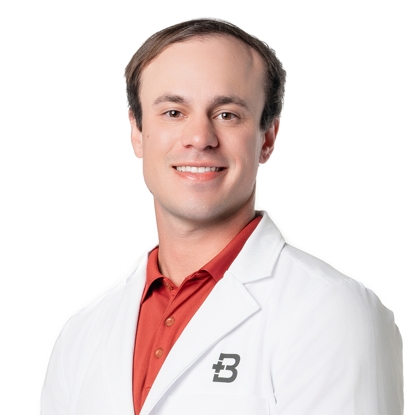The Unstoppable Dr. Knox

Marathons, Motorcycling, and Medical Milestones
Growing up on a farm and serving 41 years in medical practice may seem like two very different things, but Dr. Thomas Knox, who grew up in rural Thayer, Missouri, and began practicing in Mountain Home in 1983, begs to differ.
“As I went through medical school during my first two years, I really didn’t have a clue in terms of what I wanted to do for the rest of my life,” he said. “One of my best friend’s older brother was an orthopaedic surgeon, and my friend started talking to me about all of the things that go along with orthopaedic surgery.
“I grew up on a farm in Southern Missouri, and I realized that the practical applications of mechanics in medicine fit orthopaedic surgery and me very well. Some people go into medicine and they go into a field that maybe they aren’t suited for, but orthopaedic surgery and I were perfectly matched for one another.”
Knox earned his undergraduate degree from the University of Missouri, where he also attended medical school, after which he completed his medical internship and residency at the University of Kentucky in Lexington. He and his wife, Deborah, who he married in 1975, landed in Mountain Home after Knox’s mother began receiving treatment in the area.
“When I finished my residency and my fellowship in hand surgery, I looked all over the United States,” he said. “I had offers around a large part of the geographic United States, and my wife and I did several site visits. As I was getting ready to start my chief resident year, my mother became ill and she was hospitalized in West Plains (Missouri).
“My first-year medical instructor and one of the gastrointestinal fellows I respected greatly, Fred Turner, and Peter McKercher, a gastrointestinal fellow at the University of Missouri, had moved to Mountain Home. Peter told me about the medical community down here and how it was growing and the quality of physicians there. I thought, ‘Wow, that’s kind of interesting.’”
Knox formed a partnership with David Sward, and the two practiced together for seven years before separating their practices. Many other offers have come from outside the area through the years, but none could dislodge him from the community he’s called home.
“I enjoyed what I did here,” he said. “I’m a curious individual by nature, and I enjoy figuring things out. I think three-dimensionally, and in order to be a good orthopaedic surgeon, particularly in fracture care and the reconstruction of joints, you have to be able to imagine what you’re going to do. You have to have the ability to see the finished product in a three-dimensional aspect. I’ve always been able to do that without too much trouble. It’s like putting together a puzzle.”
During his lengthy career in orthopaedic medicine, Knox gained a stellar reputation for expertise in multiple procedures, thanks to his penchant for keeping up with the latest technology, medical protocols and surgical techniques.
“When I first started in orthopaedics, we had knee replacements which typically would only last maybe five years. Hip replacements had just been developed,” he said. “Fracture care, when I first started, we used plates and screws; the concept of locking plates, compression plates, interlocking rods like we use for complex long bone fractures now, had not been invented.
“The Swiss had come out with a system for plating that applied compression of the fractures through the plates, and this was still somewhat controversial. I think I was a fourth-year resident when I went to a course that was sponsored by the Swiss Association for the Study of Internal Fixation where we took what was called the basic fracture course. This is the sort of thing that nowadays is taught to a first-year resident as a standard of care.”
The emerging field of shoulder arthroscopy in the 1980s held particular interest for Knox. However, the lack of organized meetings meant having to proactively seek out continuing education on the subject.
“I’d been in practice two years, and a professor at UCLA, Harvard Ellman, presented a touring exhibit at our academy describing the use of arthroscopy to do a subacromial decompression, which we standardly did as an open procedure to take bone spurs off that were impinging on the rotator cuff.
“There was the San Diego shoulder study course that I flew out to attend. It was a three-day meeting where people were presenting these new experimental things and ways of looking at shoulder care that did not involve opening the shoulder per se, but you could do it arthroscopically and much less invasively. I was really excited about this.”
Knox applied what he learned through the years to the benefit of his patients back in Arkansas, but like all private practitioners, the demands of running a business meant he had to divide his attention between being a physician and being an entrepreneur. Earlier this year, he finally shed the latter role, closing his private office and joining the Baxter Health Bone & Joint Clinic.
“Number one, this allows me to devote 100% of my time to patient care without having to worry about any aspects of running an office,” he said. “If I need to take extra time off to study a problem, to go somewhere, I can do that. I don’t have to worry about if I take this time off, I’ve still got overhead to face. That’s gone.
“The hospital has been doing these outpatient clinics, and they’ve become quite efficient at doing it. I decided that the time for me to push ahead with this was now. It’s really been a nice thing because it’s taken the burden off of me worrying about end-of-month issues. I can concentrate on patient care, and when I go home every evening, it’s my time.”
As to how he spends his “me time,” Knox enjoys hobbies that aren’t typical of someone 72 years old. Until recently, he ran marathons — including the prestigious Boston Marathon — and he has held his private pilot’s license since 1979 and became instrument certified in 1983. He and Deborah also enjoy motorcycling, but not of the big cruiser variety many of his peers are into.
“I enjoy riding dirt bikes, and I enjoy riding sport touring motorcycles that are a little bit sportier than a Harley,” he said. “I enjoy the dirt bike riding particularly; we do what’s called ‘adventure bike’ where you’ll take off on a thousand-mile trip, all off-road, and you’ve got your gear packed with you, including innertubes and things you’ll need in case you have a flat tire, and inevitably you do. Deborah and I did an off-road ride through South America where we started in Punta Arenas at the tip of South America. It was about a 4,300-kilometer trip. I would say 80% of it was dirt.”
When asked about what in his long medical tenure gives him the most pride today, he said being part of the development of his field and bringing those advancements to his adopted hometown ranks at the top of the list.
“I’ve been a part of the growth of orthopaedic surgery you see today involving absolutely amazing advancements — each and every one of which has helped push the limit of the life expectancy of the artificial joints that I put in,” he said. “Thanks to imaging advancements, we now have the ability to see what’s going on in a shoulder or a knee before we ever operate on it, so we have a good idea of what we’re going to find.
“Baxter Health has been key in that as well. As the hospital has grown, it’s developed into a very good hospital — particularly considering our geographic locale and the size of our community. I don’t know that you would find a better operating orthopaedic department in the country than what we have here, and I really mean that.”

.png)

